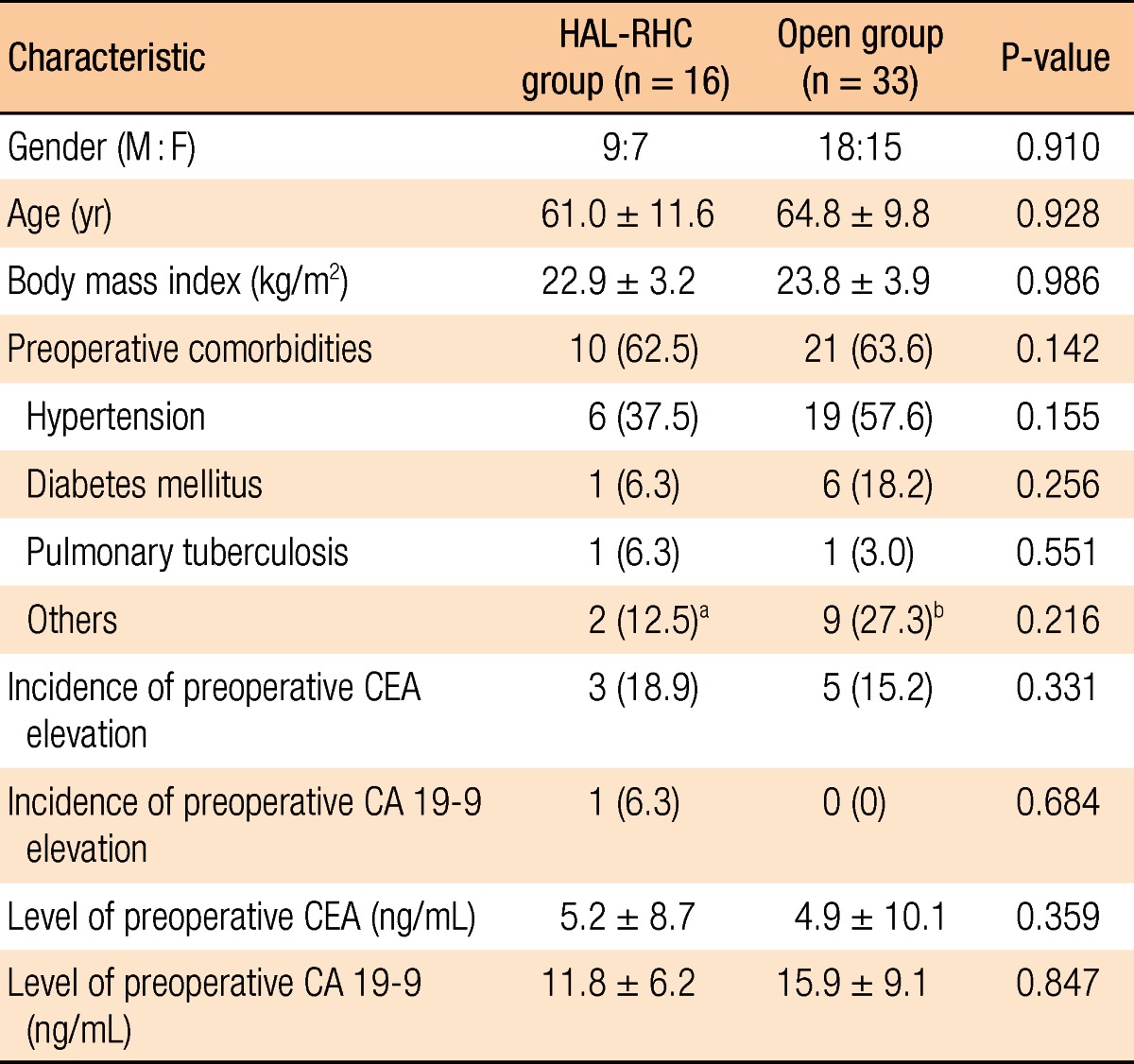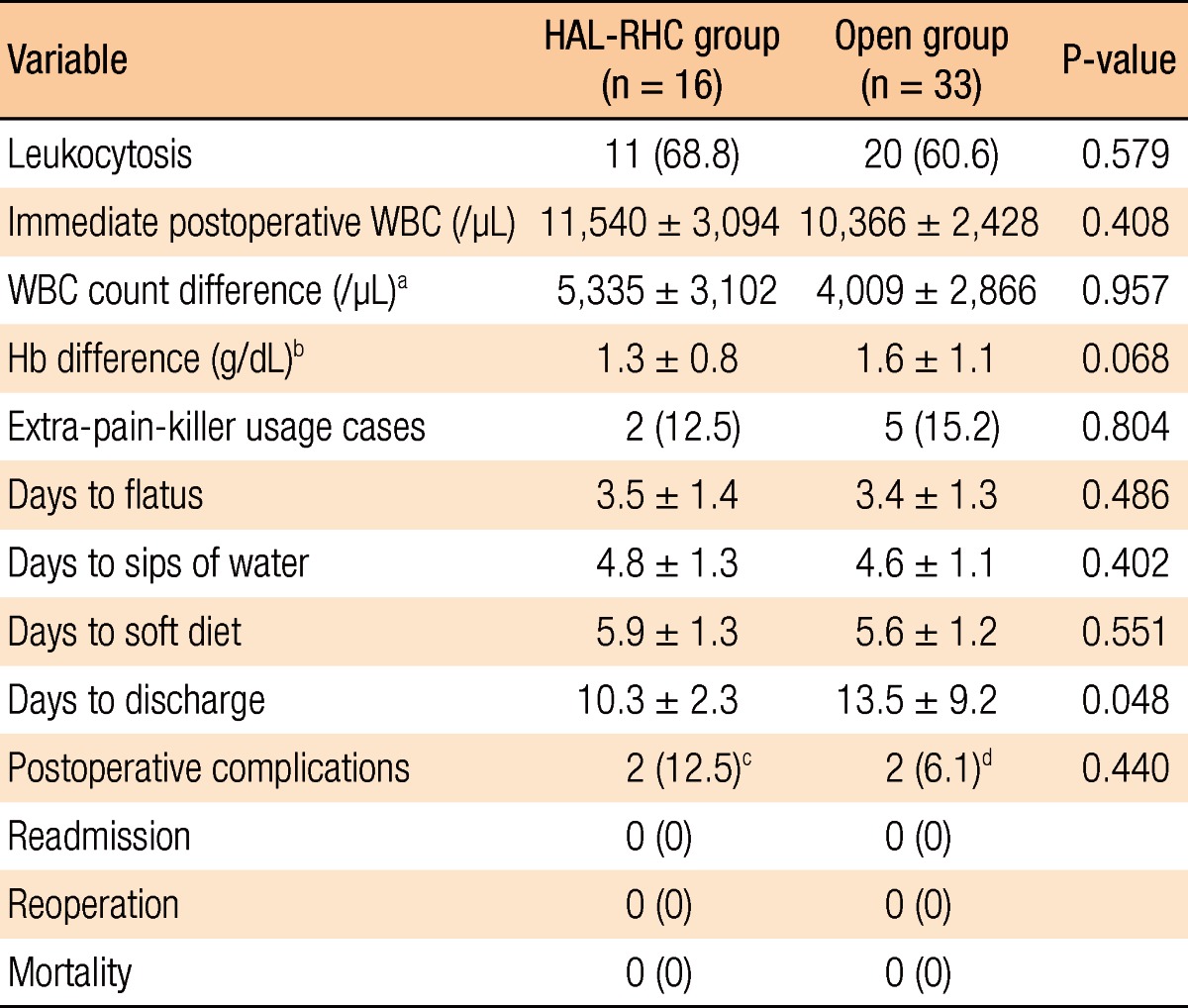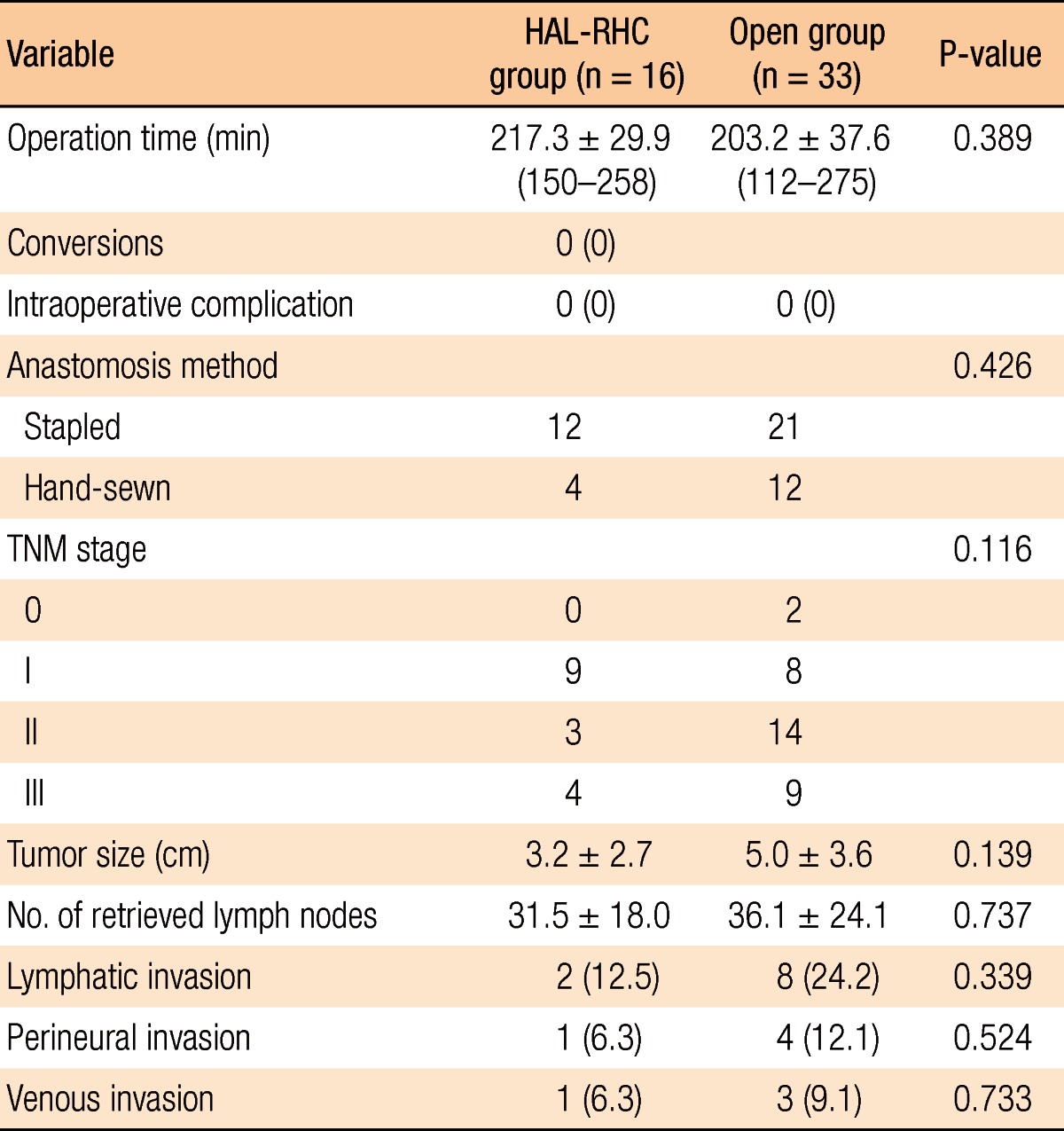1. Darzi A. Hand-assisted laparoscopic colorectal surgery. Surg Endosc 2000;14:999ŌĆō1004. PMID:
11116405.


2. Ballantyne GH, Leahy PF. Hand-assisted laparoscopic colectomy: evolution to a clinically useful technique. Dis Colon Rectum 2004;47:753ŌĆō765. PMID:
15073660.


3. Sheng QS, Lin JJ, Chen WB, Liu FL, Xu XM, Lin CZ, et al. Hand-assisted laparoscopic versus open right hemicolectomy: short-term outcomes in a single institution from China. Surg Laparosc Endosc Percutan Tech 2012;22:267ŌĆō271. PMID:
22678326.


4. Yun HR, Cho YK, Cho YB, Kim HC, Yun SH, Lee WY, et al. Comparison and short-term outcomes between hand-assisted laparoscopic surgery and conventional laparoscopic surgery for anterior resections of left-sided colon cancer. Int J Colorectal Dis 2010;25:975ŌĆō981. PMID:
20414781.


5. HALS Study Group. Hand-assisted laparoscopic surgery vs standard laparoscopic surgery for colorectal disease: a prospective randomized trial. Surg Endosc 2000;14:896ŌĆō901. PMID:
11080399.


6. Kang JC, Chung MH, Chao PC, Yeh CC, Hsiao CW, Lee TY, et al. Hand-assisted laparoscopic colectomy vs open colectomy: a prospective randomized study. Surg Endosc 2004;18:577ŌĆō581. PMID:
15026923.


7. Marcello PW. Hand-assisted laparoscopic colectomy: a helping hand? Clin Colon Rectal Surg 2004;17:125ŌĆō129. PMID:
20011257.



8. Marcello PW, Fleshman JW, Milsom JW, Read TE, Arnell TD, Birnbaum EH, et al. Hand-assisted laparoscopic vs. laparoscopic colorectal surgery: a multicenter, prospective, randomized trial. Dis Colon Rectum 2008;51:818ŌĆō826. PMID:
18418653.


9. Darzi A. Hand-assisted laparoscopic colorectal surgery. Semin Laparosc Surg 2001;8:153ŌĆō160. PMID:
11441404.


10. Cima RR, Pendlimari R, Holubar SD, Pattana-Arun J, Larson DW, Dozois EJ, et al. Utility and short-term outcomes of hand-assisted laparoscopic colorectal surgery: a single-institution experience in 1103 patients. Dis Colon Rectum 2011;54:1076ŌĆō1081. PMID:
21825886.


11. Ozturk E, da Luz Moreira A, Vogel JD. Hand-assisted laparoscopic colectomy: the learning curve is for operative speed, not for quality. Colorectal Dis 2010;12(10 Online): e304ŌĆōe309. PMID:
20070328.


12. Nakajima K, Milsom JW, Margolin DA, Szilagy EJ. Use of the surgical towel in colorectal hand-assisted laparoscopic surgery (HALS). Surg Endosc 2004;18:552ŌĆō553. PMID:
15108693.


13. Hanna GB, Elamass M, Cuschieri A. Ergonomics of hand-assisted laparoscopic surgery. Semin Laparosc Surg 2001;8:92ŌĆō95. PMID:
11441397.


14. Romanelli JR, Kelly JJ, Litwin DE. Hand-assisted laparoscopic surgery in the United States: an overview. Semin Laparosc Surg 2001;8:96ŌĆō103. PMID:
11441398.


15. Orenstein SB, Elliott HL, Reines LA, Novitsky YW. Advantages of the hand-assisted versus the open approach to elective colectomies. Surg Endosc 2011;25:1364ŌĆō1368. PMID:
20953800.


16. Chiu CC. Letter 1: short-term outcomes from a prospective randomized trial comparing laparoscopic and open surgery for colorectal cancer (Br J Surg 2009;96:1458-1467). Br J Surg 2010;97:789PMID:
20393982.


17. Aalbers AG, Doeksen A, Van Berge Henegouwen MI, Bemelman WA. Hand-assisted laparoscopic versus open approach in colorectal surgery: a systematic review. Colorectal Dis 2010;12:287ŌĆō295. PMID:
19320665.


18. Hassan I, You YN, Cima RR, Larson DW, Dozois EJ, Barnes SA, et al. Hand-assisted versus laparoscopic-assisted colorectal surgery: Practice patterns and clinical outcomes in a minimally-invasive colorectal practice. Surg Endosc 2008;22:739ŌĆō743. PMID:
17704883.


19. Targarona EM, Gracia E, Garriga J, Mart├Łnez-Bru C, Cortes M, Boluda R, et al. Prospective randomized trial comparing conventional laparoscopic colectomy with hand-assisted laparoscopic colectomy: applicability, immediate clinical outcome, inflammatory response, and cost. Surg Endosc 2002;16:234ŌĆō239. PMID:
11967670.


20. Datta V, Bann S, Hernandez J, Darzi A. Objective assessment comparing hand-assisted and conventional laparoscopic surgery. Surg Endosc 2007;21:414ŌĆō417. PMID:
17103283.


21. Southern Surgeons' Club Study Group. Handoscopic surgery: a prospective multicenter trial of a minimally invasive technique for complex abdominal surgery. Arch Surg 1999;134:477ŌĆō485. PMID:
10323419.













